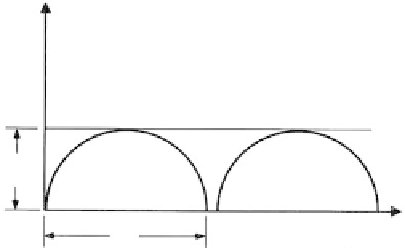Environmental Engineering Reference
In-Depth Information
stress in sensitive clays and loose fine sands that are subject to liquefaction. In soft or loose
soils, higher shear strain magnitudes result in higher values for parameter
A
.
Applications
Pore-pressure parameter
A
is used to estimate the magnitude of initial excess pore pres-
sure produced at a given point in the subsoil by a change in the total stress system. With
piezometers used to measure
in situ
pore pressures, the validity of the estimates can be
verified and the loading rate during surcharging or embankment construction can be con-
trolled to avoid failure caused by exceeding the undrained shear strength.
Undrained Shear Strength s
u
Concepts
During undrained loading in soft to firm saturated clays, the applied stress is carried
partly by the soil skeleton and partly by the pore water. Increasing the confining pressure
does not increase the diameter of Mohr's circle, since the pore pressure increases as much
as the confining pressure. The undrained strength, therefore, is independent of an increase
in normal stress (
φ
0), and as shown in Figure 3.29, is given by the expression
s
u
½
σ
d
(3.32)
where
σ
1
σ
3
) is the applied or deviator stress. In the figure,
U
c
represents the uncon-
fined compressive strength where
σ
d
(
1/2
U
c
.
For NC clays,
s
u
falls within a limited fraction of the effective overburden pressure
σ
3
0. As shown,
s
u
(
σ
v
or
p
), usually in the range
s
u
/
p
0.16 to 0.4 (based on field vane and
K
0
triaxial tests). Therefore, if
s
u
0.5
p
the clay may be considered as overconsolidated (see
Factors Affecting s
u
Values
Time rate of loading:
For soft clays,
s
u
, measured by vane shear tests, has been found to be
greater than the field strength mobilized under an embankment loading, and the differ-
ence increases with the plasticity of the clay (Casagrande, 1959; Bjerrum, 1969, 1972). The
difference is attributed to the variation in loading time rates; laboratory tests are per-
formed at much higher strain rates than those that occur during the placement of an
embankment in the field, which may take several months. A correction factor, therefore, is
τ
S
u
= C
σ
1
σ
σ
3
FIGURE 3.29
Undrained tests on saturated soil with cohesion.
U
c



